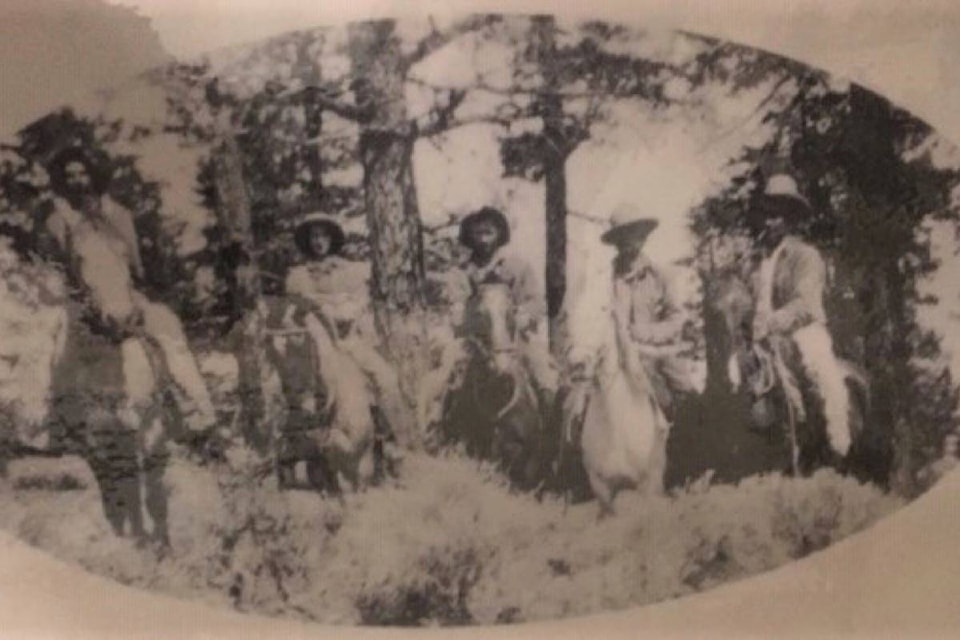Dorothy Jepp recalls High Bar winters and Christmas time in the late 1940s and early 1950s.
Winter chores were packing water and bringing wood in for the kitchen stove and living-room heater. In the fields we used a horse drawn wagon to feed home cut hay to horses, cows, sheep, and pigs. For barnyard animals we fed chickens warm water, fed sheep, and milked our cow for milk, butter, and more.
Winter travel was done by horse team and wagon or buggy, and a sleigh was used at Echo Springs when we lived there during school time. The road was not completely through High Bar – from the Big Bar end a wagon road or trail came only to Alkali Flats – so we had a teraplane car to drive to town from there.
From our house to the switchback road there was only a wagon road or trail where we would use a horse drawn wagon or buggy to go up the switchbacks to town over Cougar Point.
Christmas time included gifts, hanging stockings, hard candy, and toys, and Christmas dinner was either home-grown turkey or duck. Desserts included homemade plum pudding, fruit dumplings drizzled in brown sugar and melted homemade butter, and Christmas cakes with dried fruit; sugar and shortbread cookies were all in big supply.
Chief Joseph Moses was also known as High Bar Joe, and the legendary packer Cataline called him Skookum Joe (Skookum is a Chinook trade language word for “strong”), as he worked with him packing horses from the old Spanish Ranch just outside Clinton towards Kelly Lake. He also scribed for other people and the court system, writing English, Chinese, Spanish, Chinook, and Shuswap languages in shorthand.
Granny Moses (Isobel) from the Bonaparte Band married Joe. The two Bands made an arranged marriage for them, as they had both lost their spouses during the flu epidemic after World War I. Isobel was also known as Keeksta, and Granny would trade High Bar vegetables and fruit for moose and deer hides, which she would tan and turn into items for sale.
She made moose hides into coats, vests, mitts, moccasins (low- and high-top), and bags. Deer hides were tanned and made into clothes, gloves, and bags. She used beads and embroidery work to dress them up really pretty.
She made liners for mitts from the tops of worn-out wool socks, and she would sell them for cash or trade them at the Jesmond store for tobacco. She was well-known for her work, especially for her knitted wool socks.
An old lady named Kitty Ann Fenton would come to stay some winters, along with her yellow dog named Boots and a white horse that had a Shuswap name. She lived in a cabin alone for many years way up Lone Cabin Creek. She was still travelling about well into her 80s. The Chisholm brothers would haul hay on horseback to her cabin for her horse.
She was buried at Leon Creek in the 1950s, where she was taken by horse drawn buggy by Joe and Keeksta. Many people attended her burial.
On average we had about two inches of snow, and temperatures would sometimes drop to 20 below (Fahrenheit). Strong winds were usual and blew snow into the gullies. In 1948 we had over two feet of snow, and temperatures dropped to -50° F. The Fraser River would freeze over in the canyon areas, and ice built up along the shoreline. Ranchers would use the canyon areas as ice bridges to move livestock across the river.
Visitors would come on horseback or by foot. A priest walked from Alkali Flats, and during special guest visits a table centrepiece was put down with candles for display: it was made by Granny out of buckskin and embroidery.
editorial@accjournal.ca
Like us on Facebook and follow us on Twitter
